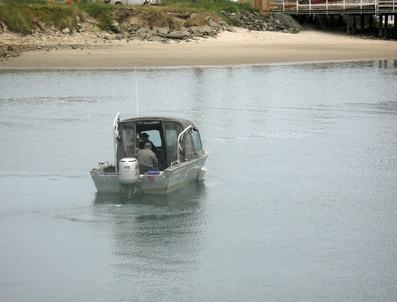
One of the best maintenance chores a boat owner can perform involves regular tune-ups and oil changes. Considering how cheap oil and filters have become, the best result for lasting engine life and performance involves regular oil and filter changes. Oil's chemical lubricating properties and viscosity break down when subjected to pollutants and extreme heat. Oil becomes useless after a prolonged period and fails to lubricate important engine parts. Changing engine oil reduces temperature and friction fatigue on moving parts. Boat owner's should change oil and replace their filter as a regular ritual.
Position the trim so your outboard motor sits in the down position. If the motor has only an engine bracket adjustment, remove the tilt pin and place the engine in the down position. If you have a freshwater inlet nozzle port on the lower unit, hook up a garden hose and adapter to the port. If no inlet port exists on your engine, place the lower unit in a full 55-gallon barrel of water. Start the engine and let it run until it reaches normal operating temperature. Shut the engine off and remove the key from the ignition.
Unclasp the top engine cowl case on your engine. It should have pressure snaps. Use a socket and wrench if it has bolts. Put the case aside. Refer to your owner's manual for the location of your oil drain plug and oil filter. On big engines it will be on the right side as you face the front of the boat. Use an Allen wrench socket, extension and ratchet to remove the upper unit side case. Set the side case aside. Pull the dipstick from the top of the engine.
Look for the oil drain Allen socket plug on the bottom of the upper unit engine block. Many times it has white paint on it. Fit your Allen socket to it and unscrew it counterclockwise with a ratchet. Hold a drain pan under the oil flow. Let it drain completely for at least five minutes. Replace the gasket washer on the drain plug with a new one and screw the Allen socket plug back into the block by hand. Tighten it with the Allen socket and wrench.
Use an oil filter wrench to loosen and remove the oil filter, which sits higher up directly over the drain plug. Place the oil drain pan underneath it to catch dribbles. Rub some residual oil on the gasket of a new oil filter and screw it in by hand. Tighten it firmly by hand and no more.
Place a funnel in the dipstick opening at the top of the engine. Look at your repair manual for the proper amount of crankcase oil to add. Some big twin motors will require five or more quarts for a primary fill. Pour in the prescribed quarts and replace the dipstick. Place the key in the ignition and start the motor. Let it run for several minutes.
Shut the engine off and remove the key. Pull the dipstick and wipe it with a rag. Insert the dipstick and take an oil level reading. Add the amount needed to properly fill the crankcase. Insert the dipstick. Replace the engine side case and mounting bolts. Use an Allen wrench or socket to tighten the mounting bolts.
Align the top rubber upper case gasket and replace the top case. Clasp the snaps on the top case by hand or use a socket to tighten the bolts.